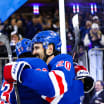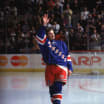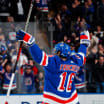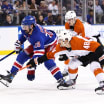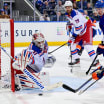SPECIAL TICKET PACKAGE: Join us on 12/2 for an exclusive pre-game meet & greet featuring the GAG Line and then witness Rangers history when Vic Hadfield's #11 is raised to the rafters at The Garden. CLICK HERE TO GET TICKETS »
Vic Hadfield describes himself this way: "I am a Ranger through and through."
He was the captain of the Rangers in the 1970s, the first 50-goal scorer in the history of the franchise, the ultimate teammate - and on Dec. 2, his No. 11 will take its place among the Rangers legends in the Garden rafters.
NYRangers.com will present 11 of the great moments of Hadfield's career, 11 snapshots of the Blueshirts' legendary left winger, 11 for No. 11 - counting down to the celebration of Vic Hadfield Night presented by Budweiser before the Blueshirts take on the Winnipeg Jets on Dec. 2 at Madison Square Garden.
We begin with how it all began.
For nearly six decades now, Vic Hadfield has bled Ranger blue. But it didn't start out that way, and it took a long-defunct system of sharing players among the Original Six and a little good fortune by way of Chicago for the Rangers to land their future legend. It happened in a boardroom at the League's summer meeting, and it seemed unremarkable at the time - even to Hadfield himself. But June 14, 1961, was a pivotal day in Blueshirts history, the day Vic Hadfield became a Ranger.
Hadfield was born in Oakville, outside Toronto and about an hour and a half's drive bending around Lake Ontario from the town of St. Catharines, where Hadfield arrived as a 17-year-old to play junior hockey for the Teepees. Hadfield was assigned to St. Catharines after signing to become property of the Chicago Black Hawks - "They owned you in those days," Hadfield said - and though he knew he lacked an NHL-caliber scorer's touch (at the time, anyway), Hadfield played an "aggressive" style of hockey, as he describes it, and making the Black Hawks was his only goal.
"Nobody was going to tell me I wasn't going to play in the National Hockey League, that I couldn't play hockey," Hadfield told NYRangers.com. "I mean nobody."
Following his second season in St. Catharines, during which Hadfield tripled his goal output from his rookie season from six to 19 and went from 20 points to 53, Hadfield participated in the Black Hawks' training camp that fall. That's where Chicago general manager Tommy Ivan called him and two other players into his office for a meeting.
Vic Hadfield Legendary Moments No. 11: Becoming A Ranger
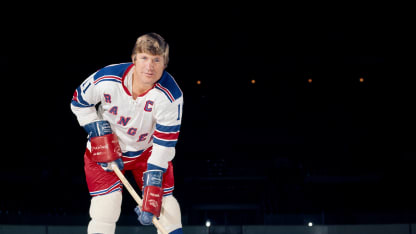
"I'm sitting there with Pierre Pilote, Elmer Vasko, and me. Here I am 19 years old, these guys are like 30 - they were like gods to me, playing all that time in the National Hockey League," Hadfield said. "But I had worked my tail off, and when they got to me that's when they said they decided they see a little bit of potential here, so we're going to turn you pro."
The Black Hawks sent him to Buffalo of the American Hockey League to start the 1960-61 season as a 19-year-old, forgoing his final season in junior - a far less common move than it is today. But turning Hadfield pro meant that, when the 1961 Intra-League Draft rolled around, Hadfield, like every professional player signed to an NHL franchise, was eligible.
The Intra-League Draft began was instituted in 1953 as a measure to introduce some parity to the six-team NHL - in reverse order of the standings, teams could claim players that the other five teams had left exposed. By 1961, teams could submit a list of 18 skaters and two goaltenders to protect. The Black Hawks initially put Hadfield on their protected list, but when they decided to pick up Autry Erickson in the second round of the draft, they had to expose someone else to make room.
That player was Hadfield. The Rangers grabbed him in Round 3.
Being sent to Buffalo, Hadfield said, "I could see, that's a step in the right direction. So I just worked harder. I went to Buffalo, kept my nose clean, worked hard at it, and I guess I showed enough for the Rangers to pick me up the next year."
Hadfield was leaving good friends in the Black Hawks organization, including Stan Mikita, his teammate on the Teepees, and Bobby Hull, who preceded him by one season in St. Catharines but who would spend time during summers with Hadfield. He said he felt no resentment toward the Black Hawks for leaving him exposed - "but I did think, with the makeup I have, 'Okay, you guys didn't think I could be good enough to play on your team, maybe I'm going to give it a little extra effort. I'm gonna to show you guys.' That's the way I handled the game."
Hadfield scored three goals in 44 games during his first season in New York, in 1961-62. Two seasons later, he scored 14 times while leading the League with 151 penalty minutes. He had his first 20-goal seaon in 1967-68, and 26 the following year. By 1971, he became captain of the Rangers. And in 1971-72 he completed the team's first 50-goal season.
No player ever taken in the Intra-League Draft scored more than Hadfield's 323 career goals and 712 points after being drafted. And he is the only future 50-goal scorer ever to change hands in that draft.
He couldn't have seen that career track coming at the time, but now he can trace it all back to a board meeting in the offseason of 1961.
"The opportunity to play in New York? Oh my goodness," Hadfield said. "First of all they showed interest in me, or they wouldn't have wasted a pick. And I took that and worked real hard that summer.
"I became a Ranger after that. And I'm still a Ranger to this day."
READ MORE: Vic Hadfield Legendary Moments No. 10: Battle With Montreal

